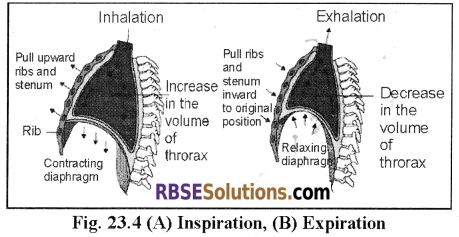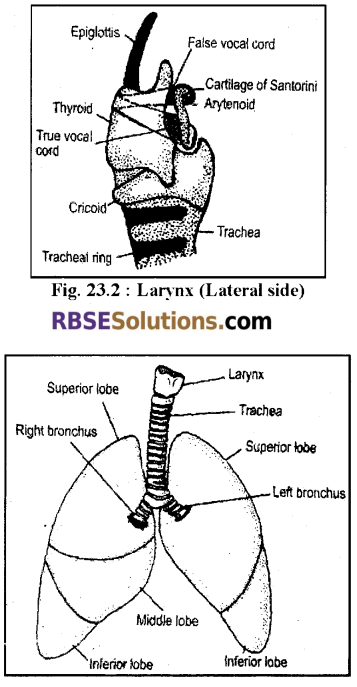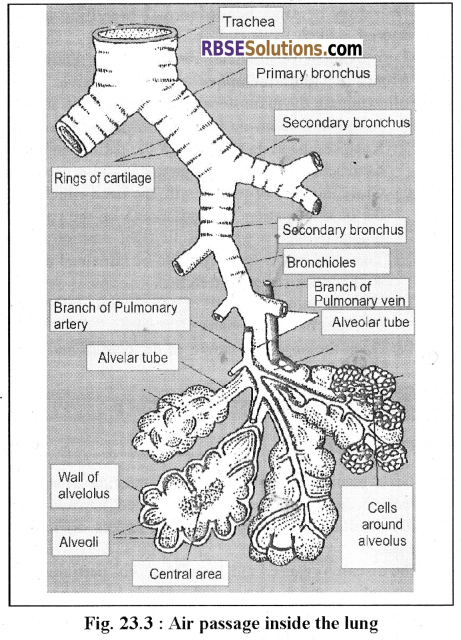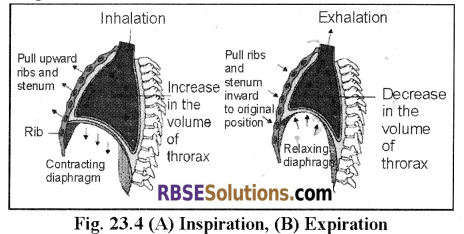Rajasthan Board RBSE Class 12 Biology Chapter 23 Man-Respiratory System
RBSE Class 12 Biology Chapter 23 Multiple Choice Questions
Question 1.
Energy used in respiration is –
(a) Physical energy
(b) Chemical energy
(c) Kinetic energy
(d) Electric energy
Answer:
(b) Chemical energy
Question 2.
During inhalation, the diaphragm is –
(a) Oblique
(b) Dome-shaped
(c) Normal
(d) Flattened
Answer:
(d) Flattened
![]()
Question 3.
During inspiration occurs –
(a) Contraction of diaphragm and external intercostal muscles.
(b) Relaxation of diaphragm and external intercostal muscles.
(c) Contraction of the only diaphragm.
(d) Relaxation of only external intercostal muscles
Answer:
(a) Contraction of diaphragm and external intercostal muscles.
Question 4.
During expiration occurs –
(a) Contraction of diaphragm and external intercostal muscles.
(b) Relaxation of diaphragm and external intercostal muscles.
(c) Relaxation of the diaphragm only.
(d) Contraction of diaphragm and external intercostal muscles.
Answer:
(b) Relaxation of diaphragm and external intercostal muscles.
Question 5.
Rate of respiration found in the resting stage of an adult is –
(a) 20 – 22 per minute
(b) 18 – 20 per minute
(c) 16 – 20 per minute
(d) 14 – 16 per minute
Answer:
(c) 16 – 20 per minute
Question 6.
Tidal Volume found in a normal man during resting phase –
(a) 1.2 litre
(b) 2.5 litre
(c) 0.5 litre
(d) 4.5 litre
Answer:
(c) 0.5 litre
Question 7.
The end part of trachea in the lung is –
(a) Bronchioles
(b) Alveoli
(c) Bronchi
(d) Air sac
Answer:
(b) Alveoli
![]()
Question 8.
Whizzing sound during expiration is signal of the disease –
(a) Emphysema
(b) Asthma
(c) Bronchitis
(d) Silicosis
Answer:
(b) Asthma
Question 9.
Labour working in the mines and factories are possible to suffer more from the diseases.
(a) Pneumonia
(b) Bronchitis
(c) Emphysema
(d) Silicosis
Answer:
(d) Silicosis
Question 10.
The total capacity of lungs is –
(a) 4600 ml
(b) 3500 ml
(c) 5800 ml
(d) 2300 ml
Answer:
(c) 5800 ml
RBSE Class 12 Biology Chapter 23 Very Short Answer Questions
Question 1.
What is external expiration?
Answer:
Giving out of the air (CO2) from the lungs into the environment is called as external respiration.
Question 2.
What is the respiratory surface?
Answer:
The surface which participates in the exchange of O2 and CO2 is called as respiratory surface.
Example: Lung alveoli.
![]()
Question 3.
Where diaphragm is found?
Answer:
It is situated between the thoracic and abdominal.
Question 4.
Write the names of inspiratory muscles.
Answer:
External and Internal intercostal muscles.
Question 5.
Write the names of two diseases caused by smoking?
Answer:
Asthma and Emphysema.
Question 6.
What is expiratory reserve volume?
Answer:
The amount of air expired over and above the normal expiration. It is from 1000 to 1100 ml.
![]()
Question 7.
What is inspiratory reserve volume?
Answer:
The amount of air inspired over and above the normal inspiration. It is from 2500 to 3000 ml.
Question 8.
What is residual volume?
Answer:
The amount of air left in the lungs after forced expiration. It is 1100 – 1200 ml.
Question 9.
What is inspiratory capacity?
Answer:
It includes tidal volume and Inspiratory reserve volume. It is 3500 ml.
![]()
Question 10.
What is a functional residual capacity?
Answer:
The amount of air left in the lungs after a normal expiration. It is 2300 ml.
Question 11.
What is the significance of artificial respiration?
Answer:
It is used to save the life of any person subjected to an accident such as gaseous toxicity, electric shock, CO, toxicity etc. The best method is mouth to mouth breathing.
RBSE Class 12 Biology Chapter 23 Short Answer Questions
Question 1.
Explain the process of inspiration.
Answer:
Inspiration:
- The entry of air into the lungs is called as inspiration or inhalation.
- It involves:
- Contraction of the diaphragm muscles. As a result, it moves downwards i.e. the diaphragm becomes flat.
- Contraction of external intercostal muscles & relaxation of internal intercostal muscles. As a result, the ribs move outward & forward i.e. anteroventral movement of the ribs. The above changes in the factors cause an increase in the thoracic volume but the thoracic pressure is reduced. Hence, due to less pressure air enters into the lungs.
![]()
Question 2.
Explain the process of expiration.
Answer:
Expiration:
- The exit of air (CO2) from the lungs is called expiration or exhalation.
- It involves:
- Relaxation of the muscles of the diaphragm, As a result, the diaphragm moves upwards & resumes dome shape.
- Contraction of internal intercostal muscles and relaxation of external intercostal muscles. As a result, the ribs move inward & backwards i.e. posterior – the dorsal movement of the ribs.
The above changes in the factors cause a decrease in the thoracic volume but the thoracic pressure is increased. Hence, due to increased pressure air comes out of the lungs.
Note: The breathing rate in adult human beings is 12 to 20 per minute.

Question 3.
Explain the process of artificial respiration.
Answer:
Artificial Respiration:
- During accidental conditions of any person such as gaseous toxicity or CO effect, electric shock etc, if breathing stops and heartbeats continue then human life can be saved by giving artificial respiration.
- Normally, the artificial respiration activates the respiratory centres, hence normal breathing can be restored.
- Many methods of artificial respiration are known but “Mouth to Mouth technique” is most effective.
- Following are the main steps for artificial respiration:
- Keep the patient on a hard bed in a straight position. Keep one hand on the head of the patient and another hand below the head, so respiratory passage gets open.
- Close the nose of the patient with the hand which is on the head of the patient and put a mouth on the patient’s mouth in such a way that airtight position forms. The hand below the head is to be remained as such so that neck remains stretched.
- Push air into the mouth of the patient forcefully about 12 times of tidal volume (500 ml).
- Open the nose and mouth of the patient and allow expiration.
![]()
Question 4.
What is Emphysema disease? How it can be prevented?
Answer:
Emphysema:
- It is caused due to heavy smoking and air pollution.
- Smoking causes continuous stimulation in the lungs which destroys the alveolar walls.
- This results in increased air space but decreases in the respiratory surface in the lungs.
- Lung elasticity is also reduced due to the increased amount of connective tissues. It causes difficulty in expiration.
- Avoiding smoking, use of antibiotics and bronchial-dilators are helpful to get relief.
Question 5.
What is respiration? Define external and internal respiration.
Answer:
Respiration:
- The body needs energy to perform various vital activities.
- This energy is obtained mainly by oxidation of carbohydrates & fats. Oxidation of these substances consumes O2 & release CO2. The process of consumption of O2 and the release of CO2 is termed as respiratory exchange.
- According to Carter, respiration involves external respiration, internal respiration & cellular respiration.
- Mammals exhibit aerial respiration which needs a respiratory system.
- The respiratory system concerns with an intake of O2 and giving out of CO2.
Types of Respiration:
The respiration is of two types:
- External respiration: It takes place in the lung alveoli. taking in of O2 and giving out of CO2 is termed as external respiration or Breathing or Ventilation. It is a physical process.
- Internal respiration: In taking of O2 by the body cells and production of CO2 and ATP is called internal or cellular respiration.
The internal respiration is of two types:
- Aerobic respiration: Cellular respiration in the presence of O2 is called aerobic respiration.
- Anaerobic respiration: The cellular respiration in lack of O2 is called anaerobic respiration.
![]()
RBSE Class 12 Biology Chapter 23 Essay Questions
Question 1.
Describe the human respiratory system.
Answer:
Respiratory Organs of Human beings:
The respiratory passage includes the following organs –
Nostrils:
- There is a pair of external nares which are situated obliquely at the tip of the snout. This condition is called as diaphanous.
- Their cavities are called as fossae or nasal passage. Both the fossae remain separated by a nasal septum which is made up of mesethmoid cartilage.
Nasal Cavities:
- The external nares open into nasal cavities which are situated dorsally to the palate. The nasal cavities open into the nasopharynx through a pair of internal nares or choanae.
- Nasal cavities are formed as an invagination of the skin and it contains a turbinal bone which is a scrolled & porous bone,
- The projections of the turbinal bones are called as conchae.
- The nasal cavities remain lined by pseudo-stratified epithelium which is ciliated & glandular.
- There are Bowmann’s glands to secrete the mucus.
- The nasal epithelium is electroreceptors and it is also called as Schneiderian epithelium.
- Functions of nasal cavities –
- It filters the inspired air
- It acts as electroreceptor
- According to new researches, it is provided with pheromones receptors.
- It maintains the temperature of inspired air by cooling’warming the air.
- It makes the inspired air moist.
Pharynx:
- Its a dorsal part is called as nasopharynx & ventral part as oro-pharynx.
- Posteriorly, it has two openings viz.-gullet (dorsal) & glottis (ventral). The gullet leads into an oesophagus & the glottis opens into a larynx.
- The glottis remains covered by a cartilaginous flap which is called as epiglottis. The epiglottis prevents the entry of food & water into the larynx.
Larynx:
- It is located in the anterior end of the throat which is formed by the modification of the anterior end of the trachea.
- It is also called a sound-producing organ.
- Formation of larynx involves 4 cartilages which are of 3 types viz.,
- Thyroid-one largest, C-shaped & forms ventrolateral sides.
- Cricoid-one, ring-like, broad dorsally & forms base of the larynx.
- Arytenoid-Two small & from the dorsal side.
- The anterior end of the arytenoid cartilage is knob-like and it is called as the cartilage of Santorini.
- The larynx has two pairs of elastic vocal cords which remain stretched between the thyroid and arytenoid cartilages:
- Anterior or False vocal cords
- Inelastic & pinkish in colour.
- Posterior or True vocal cords.

Trachea or Windpipe:
- It is a simple tube which is elastic & semi-transparent.
- Its length in man is of 10 cm.
- It is located in the neck ventral to the oesophagus.
- It is lined by pseudostratified epithelium & ciliated internally. These cilia beat constantly to force out the mucous.
- The trachea is supported by tracheal rings made up of hyaline cartilage. These rings are C-shaped i.e. incomplete dorsally to facilitate oesophageal movements.
- The posterior end of trachea bifurcates to form two bronchi. These bronchi are also thin-walled & elastic but they are supported by complete cartilaginous rings. Each bronchus enters into its respective lung.
Lungs:
- Man has a pair of lungs which are situated in the thoracic cavity on both the sides of the heart.
- The lungs are elastic, spongy, light pink, unequal & without muscles.
- In the human being, the left lung consists of two lobes viz., left superior lobe & left inferior lobe. Whereas, the right lung includes three lobes viz.-superior lobe, middle lobe & inferior lobe.
- Each lung is bounded by two pleural membranes viz.,
- External or Parietal pleuron.
- Internal or Visceral pleuron.
- Both the pleura remain closely applied to each other.
- The space between the lung and the pleura is called a pleural cavity.
- Each bronchus enters into the lung of own side & divide to form secondary or lobular bronchi (4 secondary bronchi in right lung & 2 secondary bronchi in the left lung).
- Each secondary bronchus divides to form tertiary or segmental bronchi, which further divide to form intrapulmonary bronchi. The ends of intrapulmonary bronchi divide to form terminal bronchioles which further form respiratory bronchioles.
- These bronchioles lack cartilaginous rings. Each respiratory bronchiole gives out 2 to 11 alveolar ducts. Each alveolar duct gives out small ducts, the atria. Each atrium forms small bag-like alveoli or air sacs which are made up of squamous epithelium.
- Internally, the alveolus is lined by mucous & there is a network of blood capillaries outside. The alveoli provide more surface for the exchange of gases.
- The diameter of a lung alveolus is 0.2 mm.

Question 2.
Explain the process of respiration and its role.
Answer:
Respiration process involves two steps:
- Inspiration
- Expiration
1. Inspiration:
- The entry of air into the lungs is called as inspiration or inhalation.
- It involves:
- Contraction of the diaphragm muscles. As a result, it moves downwards i.e. the diaphragm becomes flat.
- Contraction of external intercostal muscles & relaxation of internal intercostal muscles. As a result, the ribs move outward & forward i.e. anteroventral movement of the ribs.
The above changes in the factors cause an increase in the thoracic volume but the thoracic pressure is reduced. Hence, due to less pressure air enters into the lungs.
2. Expiration:
- The exit of air (CO2) from the lungs is called expiration or exhalation.
- It involves:
- Relaxation of the muscles of the diaphragm, As a result, the diaphragm moves upwards & resumes dome shape.
- Contraction of internal intercostal muscles and relaxation of external intercostal muscles. As a result, the ribs move inward & backwards i.e. posterior – the dorsal movement of the ribs.
The above changes in the factors cause a decrease in the thoracic volume but the thoracic pressure is increased. Hence, due to increased pressure air comes out of the lungs.
Note: The breathing rate in adult human beings is 12 to 20 per minute.

Question 3.
Write short notes on:
- Artificial respiration
- Respiratory diseases
- Respiratory volumes
Answer:
1. Artificial Respiration:
- During accidental conditions of any person such as gaseous toxicity or CO effect, electric shock etc, if breathing stops and heartbeats continue then human life can be saved by giving artificial respiration.
- Normally, the artificial respiration activates the respiratory centres, hence normal breathing can be restored.
- Many methods of artificial respiration are known but “Mouth to Mouth technique” is most effective.
- Following are the main steps for artificial respiration:
- Keep the patient on a hard bed in a straight position. Keep one hand on the head of the patient and another hand below the head, so respiratory passage gets open.
- Close the nose of the patient with the hand which is on the head of the patient and put a mouth on the patient’s mouth in such a way that airtight position forms. The hand below the head is to be remained as such so that neck remains stretched.
- Push air into the mouth of the patient forcefully about 12 times of tidal volume (500 ml).
- Open the nose and mouth of the patient and allow expiration.
2. Respiratory disorders:
Asthma:
- It is a respiratory disease. It is a condition in which a person’s air passage becomes inflamed, narrow, swells and produces more mucus, which makes difficult to breathe.
- The disease is caused due to pollens, dust particles, cold or smoking etc. It causes difficulty in breathing, chest pain, coughing and wheezing. The best remedy to prevent asthma is to live away from allergens.
- Asthma can be managed with rescue inhalers to treat symptoms i.e. bronchodilators. Antibiotics are required to cure it.
Bronchitis:
- This disease involves inflammation of the timing of bronchial tubes which carry air to and fro from the lungs.
- Symptoms include – swelling on the internal lining of bronchitis that causes constant coughing. Bronchitis may be acute or chronic.
- It may also be due to chemicals in the smoke of tobacco. Avoiding smoking is the best way to prevent asthma.
Emphysema:
- It is caused due to heavy smoking and air pollution.
- Smoking causes continuous stimulation in the lungs which destroys the alveolar walls.
- This results in increased air space but decreases in the respiratory surface in the lungs.
- Lung elasticity is also reduced due to the increased amount of connective tissues. It causes difficulty in expiration.
- Avoiding smoking, use of antibiotics and bronchial-dilators are helpful to get relief.
Pneumonia:
- It is an infectious disease which is caused by the infection of streptococcus pneumonia bacteria.
- The lung alveoli get filled with dead cells (WBC) and fluid because of infection.
- The patient faces breathing problems.
- It is more common during childhood and old age.
- Antibiotics and bronchodilators are beneficial in curing.
Cancer of Lung:
- Its main cause is smoking.
- The chemicals present in the smoke of cigarettes are carcinogens.
- The smoke may cause irregular cell divisions in bronchioles and slowly cause being cancer.
![]()
Silicosis and Asbestosis:
- These diseases are due to air pollution.
- Mainly, they occur in persons who are working at mines and factories of silica and asbestos.
- The particles of silica or asbestos enter into the lungs and cause fibrosis in the upper part of the lungs.
- These diseases are not curable, hence prevention is better.
3. Respiratory volumes:
- Tidal Volume (TV) – The amount of air expired/inspired during one breath is termed as tidal volume. It is 500 ml in human beings.
- Inspiratory Reserve Volume (IRV] – The amount of air inspired over and above the normal inspiration. It is 2500 to 3000 ml in human beings.
- Expiratory Reserve Volume [ERV] – The amount of air expired over and above the normal expiration. It is 1000 to 1100 ml in human beings.
- Residual air (RV) – It is the amount of air left in both the lungs after forced expiration. It is about 1100 to 1500 ml in human beings.
- Inspiratory Capacity (IC) – The maximum inspired air is called as IC. It includes tidal volume and IRV. It is about 3500 ml in human beings.
- Expiratory Capacity (EC) – The maximum expired air is called as EC. It includes TV + ERV. It is about 1500 to 1600 ml. in human beings.
- Functional Residual Capacity (FRC) – The amount of air left in the lungs after a normal expiration. It includes RV + ERV. It is about 2300 ml in human beings.
- Vital Capacity (VC) – The amount of air expired maximum from both the lungs. It is IRV + TV + ERV. In human beings, it is 4600 ml.
- Total Lung Capacity (TLC) – The total amount of air in both the lungs is called TLC. It is VC + RV. It is 5800 ml in human beings.